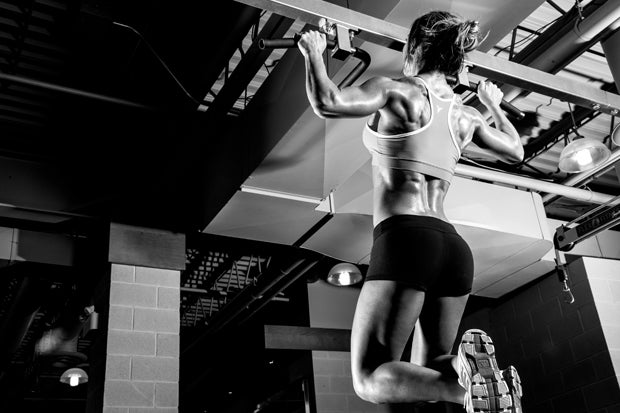Heading out the door? Read this article on the new Outside+ app available now on iOS devices for members! Download the app.
What can leave a woman’s heart pounding faster than Jon Hamm on of Mad Men?
The thought of repping it out at the pull-up bar.
Considered one of the best gauges of upper-body strength, pull-ups are often absent from women’s training routines. But while it can be more difficult for ladies to perform this compound exercise compared to men—you can thank our weight distribution (think: pear shape), weaker relative upper-body strength, and a higher ratio of fat to muscle—it’s not entirely impossible. Use our guild to go from “none” to “some” in only 10 weeks. We’re not saying it won’t be tough, but the stares you’ll pretend to ignore in the gym as you hoist your chin about that bar will be totally worth it.
Practice Makes Perfect
You’ll need to start by getting familiar with the mechanics of the exercise. “A pull-up is a unique movement, and your muscles will need to contract in a certain way to make that happen,” says Bob LeFavi PhD, CSCS, and professor of sports medicine at Armstrong Atlantic State University in Savannah, Georgia. “So you’ve got to do some pull-ups, either with or without assistance, to get better at pull-ups.” The perfect pull-up has two distinct steps:
- Dead Hang: Grasp a pull-up bar with a wide overhand grip (palms facing away from you). Allow your body to hang freely, shoulders relaxed. If you have enough space, let your feet hang straight down; if not, tighten your abs and look up.
- Full Contraction: Drive your elbows towards the floor, pull your shoulder blades together and lift your chest towards the bar. Do not swing or use momentum to help you up. At the top of the move, your elbows should form 90-degree angles, and your chin should be level with or just over the bar. Slowly lower all the way until you are in a dead hang.
The good news for pull-up newbies is that there are several ways to perform assisted pull-ups using the same motion as described above. Doing these regularly will help develop the neurological pathways—how your brain and body speak to each other—that make performing a pull-up possible.
See Also8 Exercises Every Woman Should Do
Superbands: These large rubber bands vary in thickness and can help you do a pull-up by partially supporting your weight. Loop the band through itself over a high pull-up bar. Stretch the band downward and place your feet or knees into the band loop, and come into a dead hang before beginning the first rep of your set.
Assisted Machines: Pull-up machines use plates or air pressure to counterbalance your bodyweight. Set the machine appropriately for your capability (more weight makes the machine move easier) and grasp the bar overhead. Kneel on the platform and extend your arms until you are in a dead hang before starting your set.
Spotter: A spotter is a partner who assists by manually helping support some of your weight. Take a wide overhand grip on the pull-up bar. Have a spotter stand behind you and place her hands underneath your shoes or shins, offering assistance in the form of an upward thrust as you hit sticking points during your reps.

Have a Breakdown
Split each rep into smaller portions to bolster strength in specific areas of your back. “Try doing partial reps using assistance,” suggests Jimmy Peña, CSCS. “Training in sections will eventually contribute to strengthening your total range of motion.” Divide your reps into three parts, doing some in the top half of the range of motion, some in the bottom half, and some using the full range of motion.
Create a Support System
To further develop those neurological pathways, you’ll need to train the muscles that you actually use during a pull-up. “As your strength increases in the primary movers—the upper lats and arms—the actually pull-up will become easier to perform,” says Peña. “Pulldowns, bend-over rows and other wide-grip moves will help strengthen and target the lats, arms and shoulders.” The moves below will be the backbone of your program, and will go a long way to increasing your capacity for pull-ups.
Back
- Bent-over barbell rows
- Wide-grip pulldowns
- One-arm dumbbell rows
- Seated cable rows
- Chin-ups
Biceps
- Dumbbell hammer curls
- Barbell curls
- Seated incline dumbbell curls
- Preacher curls
Core
- Hanging knee raises
- Cable rope crunches
- Planks
- Stability-ball crunches
Get Negative
“We are much stronger in a negative contraction than we are in a positive one,” notes Peña. “Even though you may not have the strength to pull yourself up for a rep or a full set, you do have the strength to hold yourself up and slowly lower to the start., which will also help strengthen your muscles and increase your pull-up potential.”
Negative pull-ups: Place a bench under a pull-up bar. Take a wide overhand grip, and jump up to the peak contraction position, with your chest near the bar. Hold here for a moment, then lower yourself as slowly as possible to return to the start. Replace your feet on the bench, jump back up and repeat.

Put It Together
Now that you have a plan of attack, you need to figure out your starting point. Hop up to a bar (of the metal, not liquid, variety) and see how many pull-ups you can actually do. Those who can’t do any should set a goal of three to five by the end of 10 weeks, while those who can do two or more can shoot for eight to 10.
To test your progress, try doing an unassisted pull-up every week. If you feel far off from your goal by week five, rethink and readjust what you are aiming for to something more manageable. Here we’ve provided you with a schedule that works our progressive pull-up plan into a weekly strength routine that targets all of your major muscle groups for well-rounded development.
Weeks 1–3
For your first three weeks, focus on developing strength. Do negative pull-ups twice a week (starting at the top of a pull-up and slowly lowering back to the start), aiming for one or two sets of five to eight reps. Do assisted pull-up on a separate day, going for two or three sets of 10 to 15 reps. For your back and biceps workouts, do three heavy sets of six to eight reps for each exercise. Finally, on your core days, do 10 to 15 reps of each move. (Hold the plank for up to one minute.)
Monday: Negative Pull-ups; back
Tuesday: Chest, Triceps, Core
Wednesday: Off
Thursday: Negative Pull-ups, Legs
Friday: Shoulders, Core
Saturday: Assisted Pull-ups, Biceps
Sunday: Off
Weeks 4–7
During these weeks, add assisted partial pull-ups to your roster: do two or three sets of 21 reps (seven in the top and bottom halves, as well as seven working through the full range of motion). Use a moderate weight for your back and biceps, going for three sets of eight to 10 reps, and for your core, shoot for three or four sets of 10 to 12 reps. (Hold the plank for a minute or more.)
Monday: Chest, Core
Tuesday: Assisted Partial Pull-ups, Back
Wednesday: Off
Thursday: Negative Pull-ups, Biceps, Triceps
Friday: Legs, Core
Saturday: Off
Sunday: Assisted Pull-ups, Shoulders
Weeks 8–10
This is your final stretch, so choose a thinner band, decrease the weight on the machine, or rely less on your partner during your assisted pull-ups. “The body will change according to the level at which it’s stressed, so week after week, your need for help will decrease,” says Peña. Lighten the load on your biceps and back days, and do three sets of 12 to 15 reps so you have plenty of energy to do pull-ups. For your core, do three sets of 10 to 12 reps for each move. (Hold the plank as long as you can.)
Monday: Assisted Partial Pull-ups, Legs
Tuesday: Chest, Triceps, Core
Wednesday: Assisted Pull-Ups, Back
Thursday: Negative Pull-ups, Legs
Friday: Shoulders, Core
Saturday: Assisted Pull-ups, Biceps
Sunday: Off
